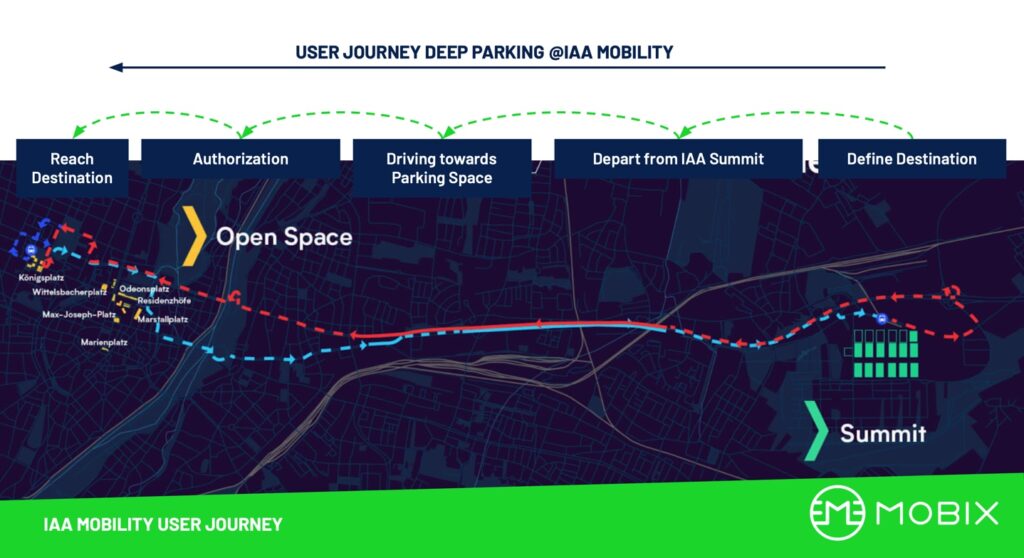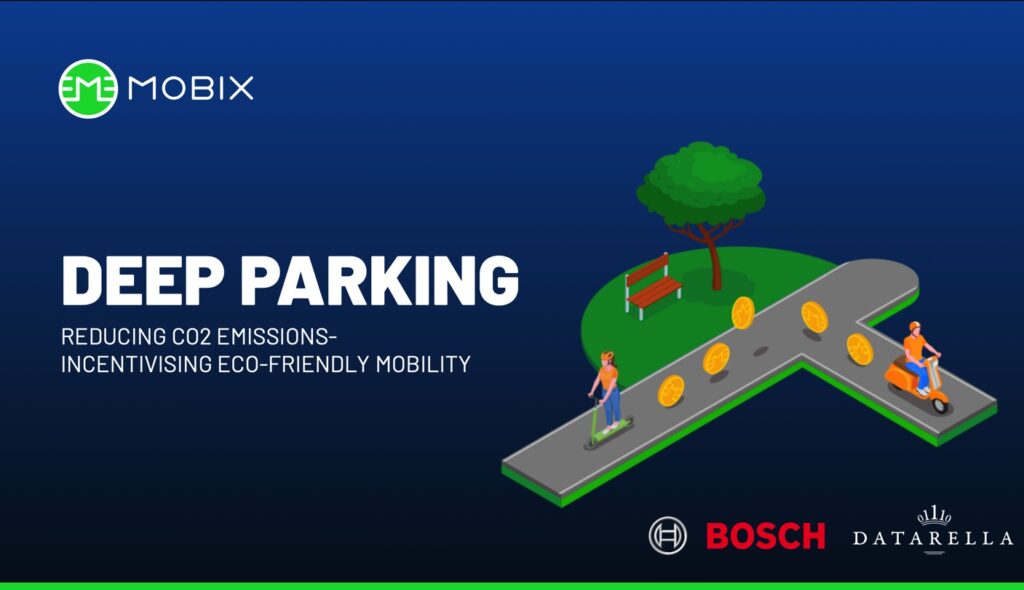If you’re unfamiliar with the term ‘multi-modal transport’ then you’re to be forgiven – up to this point the term has predominately been used within the freight industry, and only sparingly within urban planning departments. On the few occasions it has been used in relation to micromobility, it has primarily been used in relation to micromobility providers offering pedal bikes, e-bikes and e-scooters in a single geographical area.
In this blog post, we will be redefining the term ‘multi-modal transport’, as a new version of ‘park & ride’, illustrating how this new concept represents one of MOBIX’s key use-cases and be announcing the details of an exciting demonstration of this capability at the renowned International Mobility Show (IAA Mobility).
What is Multi-Modal Transport?
Within the United Nations Convention on International Multimodal Transport of Goods, multi-modal transport has been defined as;
“… the carriage of goods by at least two different modes of transport…”.
However, if we replace ‘of goods’ with ‘of people’, then we have a new, viable definition for use within the fields of micromobility and transport, as in “park & ride”. Naturally, repurposing the term itself to apply to the future of micromobility is not enough; we need to develop further concepts that would facilitate the application of multimodality to micromobility and support the future of transport.
When we take journeys across towns and cities, we will occasionally take both the bus and the train- typically if we’re heading to a less connected metropolitan area (this is where multimodality and urban planning has historically intersected). But what if we’re planning another kind of journey…
What if we drive?
Historically, multimodality was a key aspect of city planning. However, with the growth of car ownership over the 20th century, many cities are now, on the whole, automobile-orientated. In our modern era though, municipalities now need to find methods to reduce the high levels of (combustion engine) motor traffic on their roads. Ride-sharing was the first step in this direction, but it has not resulted in an effective enough solution by itself and citizens are still utilising more traditional, environmentally inefficient forms of transportation.

Within urban areas, finding a parking space will typically consume around 41 hours of an urban driver’s time per year. This time, plus fuel and accompanying C02 emissions, equate to a total of 896 euros annually. In Germany alone, this amounts to 40.4 billion euros per year.
What is the solution? Well, as has been pointed out by numerous individuals and organisations, there are countless parking spaces dotted around metropolitan areas that languish, unused for not-insubstantial periods of time, but remain exclusively reserved. Further, these spaces have remained unused due to administrative hurdles and/or poor connections to existing micromobility services… but how do we now utilise these spaces in relation to multi-modality and micromobility?
The MOBIX Deep Parking Extension
MOBIX Deep Parking will make these previously unused parking spaces useable by incentivising their owners to offer them for use through a blockchain-based reward system (MOBIX Miles).
MOBIX’s virtual autonomous agents, powered by Fetch.ai, will record the utilisation of these parking spaces in a particular area, as well as the availability of micromobility services, and then offer these options to an approaching motorist, who can then easily store their car and reach their destination without having to waste their time and petrol searching for a car parking space.
The users of the technology will also receive MOBIX Miles for their usage of the deep parking extension. More environmentally friendly alternatives will be incentivised with more MOBIX Miles, and if the driver accepts the multimodal micromobility journey plotted by the agent, then they will receive further reward miles.
This entire process is handled intermodally through the MOBIX Wallet, totally securely and in full compliance with GDPR privacy regulations through integrated Self-Sovereign Identity SSI technology (thanks to MOBIX partner Datarella).
The IAA Mobility
The IAA is typically known as the International Car Show but is named the Internationale Automobil-Ausstellung (IAA) in German. It is renowned as the world’s largest mobility show/conference, and this year, for the first time it is held in Munich, from 7 – 12 September, with an extended exhibition offering including all kinds of mobility products and services. Numerous mobility providers present at the show, ranging from car companies presenting concept cars to cutting-edge technology companies.
For more information make sure to check out the IAA Mobility website here.

Announcing the MOBIX Deep Parking IAA Mobility Demonstration
At the IAA Mobility, partners BOSCH, Datarella, Fetch.ai, Ocean Protocol and MOBIX demonstrate a busload of technology in one demonstrator: Deep Parking, originally prototyped in Datarella’s M-ZONE project in December 2020. The IAA Mobility’s Blue Lane, a traffic lane for zero-emission vehicles, is going to be used to carry out test drives for conference attendants. Deep Parking will be demonstrated from 7-12 September, however, the Blue Lane will stay and be extended towards an environmental traffic lane throughout the city of Munich. Learn more about the IAA’s Blue Lane here.

Three electric cars, a Jaguar iPace, a Tesla, and a BMW, equipped with their own, car-based Self-Sovereign Identities, are going to be conducting the journeys and the attendants will be among the first to experience Deep Parking and part of the future of multimodal transport! The attendants can search for and find parking space within the city centre that has formerly been inaccessible. While existing, and available in principle, this parking space belongs to either a corporate building, a municipal building, or a private building. To date, this parking space was exclusively accessible to a limited group of authorized users. Now, users can reserve, use, and pay for this parking space thanks to the Deep Parking technology.
Enter MOBIX!

Often, drivers can’t park in close proximity to their final destination. Or, they have multiple destinations but do not want to move the car. Micromobility is the solution. Riding a scooter, or even using a cargo bike to transport groceries. MOBIX is the natural extension of Deep Parking: while reserving her deep parking space, the user also finds and reserves a nearby scooter that will be waiting to be unlocked by her after she will have parked her car. This is multi-modal mobility at its best: MOBIX Agents do all the work of searching, finding, reserving and paying for the parking space, as well as the micromobility, on behalf of her owner through the MOBIX Wallet.
And then, there is an additional hidden gem incorporated in Deep Parking: in the background of the above-mentioned user story, all sorts of Fetch.ai autonomous agents’ activities are happening in a completely privacy-preserving, GDPR-compliant way – leveraging the Compute-to-Data approach, a technology provided by our partners at Ocean Protocol.
Watch this space for more news about the IAA Mobility, MOBIX rewards and micromobility – and make sure to check out our Telegram and Twitter!


You must be logged in to post a comment.